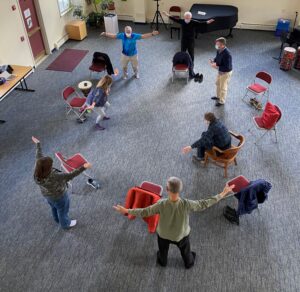Tuned in to healing: How movement, song can be a health benefit
By Heather Bigelow Hearne
This article was published in the Concord Monitor on October 20, 2022. Click here to view the pdf of the original article.
 As we move into our later years of life, several health and wellness problems start to collect in our daily lives. Some people develop memory loss, issues with balance, depression or changes in mood, muscle and body rigidity, changes in cognitive processing, decreased social engagement, change in speech patterns and diction, increased stress, and a desire for a better quality of life.
As we move into our later years of life, several health and wellness problems start to collect in our daily lives. Some people develop memory loss, issues with balance, depression or changes in mood, muscle and body rigidity, changes in cognitive processing, decreased social engagement, change in speech patterns and diction, increased stress, and a desire for a better quality of life.
Yet, there are ways to address these struggles and better one’s quality of life, in the older years, through dance and song mixed with therapy.

Heather Bigelow Hearne R-DMT has worked as a dance movement therapist at the Concord Community Music School for 22 years. In my work with various ages and populations, I have seen, firsthand, how important it is to meet a person where they are at, treat each individual as a whole, lead with compassion, and allow the body to start the conversation. Dance Movement Therapy is the psychotherapeutic use of movement in the body to promote emotional, social, behavioral, cognitive, and physical integration within an individual for the purpose of improving health and wellbeing and quality of life. In dance movement therapy we have a sense of treating the body as a whole and we bring this wholeness to our clients. We work in the moment through our authentic knowledge and give each moment and each movement a validity. As people age in the United States the stigma of aging is placed upon them. In our groups we remove the stigma and create a safe place for everyone to feel known, equal, and valuable.
In my groups, there are moments to express oneself through song and drumming, time to engage muscles and bodies in a warm up for joint health and flexibility, movement and song time to enhance mood, memory, speech and language, motor ability, all while decreasing stress, loneliness, and depression.
Movement is the first form of communication. It is our way of not only getting from one place to another but also our way of expressing our emotions, memories, desires, and needs. When we move our bodies through life, we develop movement patterns which sometimes block a healthy way of living. In movement and song groups we have moments to restructure and reintegrate these patterns through practice, mental, emotional, and physical restructuring as we move and sing within a dance movement therapy group. It sounds so scientific yet in the classes “Movement and Song for Memory” or “Movement and Song for Mobility,” group members get to play a rhythm on a drum, sing while shaking a maraca, walk about the room to a rhythmic song, move and express a memory, laugh and tell a story, dance with each other in a safe and healthy place, and learn tools to bring home for better living.
